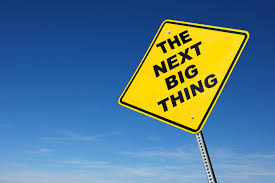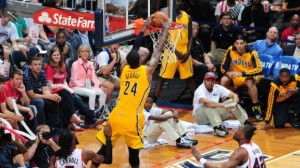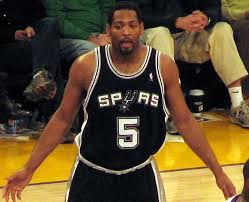 Something to think about as we barrel toward Thursday night’s draft: Beware the comparisons … you know, the “he is the next (fill in the blank).” Like Joel Embiid, who is either the next Hakeem Olajuwon or the next Greg Oden.
Something to think about as we barrel toward Thursday night’s draft: Beware the comparisons … you know, the “he is the next (fill in the blank).” Like Joel Embiid, who is either the next Hakeem Olajuwon or the next Greg Oden.
Basketball is the most nuanced and elaborated game there is, and this is why NBA Comps are nothing more than bad smokescreens.
Take a look at Penny Hardaway for a second. What do you see? You see a long ball-handler, ultra-quick and smooth as an alley cat. Penny had a certain simplicity about him that made his brilliance seem obvious. Almost casual. He would scan the floor while going around his defender, and read it like a story as it unfolds. He wouldn’t go for the home run-play as much as he would elevate the simple play and make it the home run-play itself. Penny was athletically gifted in a way that allowed him to flourish playing that type of basketball back in the 90’s. You can argue he wasn’t as dominant as his talent suggested, even before his injuries robbed him.
 Now look at Dante Exum. What do you see? Probably, just an ultra-quick, long ball-handler. Is he Penny’s stunt double? Maybe. We simply don’t know yet; the picture is too fuzzy.
Now look at Dante Exum. What do you see? Probably, just an ultra-quick, long ball-handler. Is he Penny’s stunt double? Maybe. We simply don’t know yet; the picture is too fuzzy.
What we do know is that this isn’t the 90’s (not nearly as many boy-bands and ripped jeans).
When you make a comp for a player in the upcoming draft, you are trying to build on past information you hope is there. It’s a shortcut, and often times it leads you the wrong way.
We have all these comps flying around lately, every draft hopeful has one. They are even trained to answer that very question when interviewed. Zach LaVine, for instance, fancies himself as a hybrid of Russell Westbrook, Stephen Curry and Jamal Crawford. Kind of overdid it, wouldn’t you say?
We make comps partly because we need to picture the player in the NBA settings, but we oversimplify the process. Boris Diaw was a bust in Atlanta, but this year he was a key part for one of the most impressive title runs we have ever seen, playing for the Spurs. Let’s say we switch Jordan Hill (8th pick, New York Knicks) with Taj Gibson (26th, Chicago Bulls, same draft) – wouldn’t it have an effect on their careers? Are you sure they would develop just the same with different teams, different coaching?
Opportunity matters. Coaching matters. Roster context. Recent league rule changes. It’s all a part of the evaluation process. A process that is being completely ignored when you simply label a guy with the name of a different guy.
 Keep in mind, the players change throughout their careers. Players evolve, refine their skill set to their team needs, they lose their athleticism and gain wisdom that come with years of experience and coaching. This makes them a moving target.
Keep in mind, the players change throughout their careers. Players evolve, refine their skill set to their team needs, they lose their athleticism and gain wisdom that come with years of experience and coaching. This makes them a moving target.
Noah Vonleh is Chris Bosh? Which Chris Bosh would that be? The 24-and-10 guy from Toronto? The spot up stretch-5 from the heat? It’s all a mess.
Remember when Anthony Randolph was Lamar Odom 2.0 ? Bismack Biyombo was Serge Ibaka’s second coming, and every long athletic wing that wasn’t going to lead a team in scoring was suddenly Scottie freakin’ Pippen?
So, why do we even do it?
Well, comps are fun as they are easy, and they even serve a purpose for all of us busy bees out there. So let us regroup and start over… as the great Joey Tribiani once said:” If you’re gonna do something wrong – do it right.”
Here are a few “Dos and Don’ts” to help us out when making a comp.
First off, skin color cannot be the only factor when making a comp (Kyle Korver exits the stage, leaving Doug McDermott in his white wake). Being lefty is also not enough. Same goes for coming from the same country or college.
Now, what do we do? Oddly enough, the way to fix the comp-game without ending it altogether, is to have more comps…
 I’ll demonstrate. Let’s take Aaron Gordon this time. You can make a case that his comp is Shawn Marion. You can also throw Blake Griffin’s name in there and see if it sticks. But only when you hear the two names at the same time can you really deduce something about Gordon.
I’ll demonstrate. Let’s take Aaron Gordon this time. You can make a case that his comp is Shawn Marion. You can also throw Blake Griffin’s name in there and see if it sticks. But only when you hear the two names at the same time can you really deduce something about Gordon.
Is he going to average 20 a game as a rookie, while overpowering most PFs? That’s a “no.” Does his jumper looks like it just came out of a cartoon, like Marion’s jumper? Again, no. So what do both comps have in common?
It seems that scouts feel that Gordon is an elite athlete with extremely versatile skill set who cannot shoot, but may be able to fix it as he matures. You see what we did there? The prospect is no longer a clone, but a player with a game that resembles others. He no longer has to take on their entire personality, team situation or career accolades. No more “Copy-Paste” type of thinking.
Some more “Basic Comps – 101” for you:
A few guys became something like “go-to comps”, so watch out whenever their name comes up – you might be played by a savvy agent. It’s basically one big land mine, so you want to have a guide going through it. Here are a few easy ones to watch out for:
 Paul George – The flavor of the summer. If your guy is tall, skinny and cannot really do much with the ball, he might be Paul George – just waiting to blossom majestically into a franchise building block.
Paul George – The flavor of the summer. If your guy is tall, skinny and cannot really do much with the ball, he might be Paul George – just waiting to blossom majestically into a franchise building block.
It plays on our deep insecurities – no one gave George a second thought as he was coming into the league, and you wouldn’t want to be fooled twice.
A few names that are worth mentioning as “Not Paul George”: Jeremy Grant, Cleanthony Early, Glenn Robinson III. And that’s only this year’s draft! I will have none of that. George’s road to super-stardom was a like a unicorn’s. Becoming a max player after being under every team’s radar is almost unheard of.
 Robert Horry – That is a great one, Horry did not have a career body of work to suggest he is anything super special, but he did hit some key shots that will go down in history as epic, championship clinching moments.
Robert Horry – That is a great one, Horry did not have a career body of work to suggest he is anything super special, but he did hit some key shots that will go down in history as epic, championship clinching moments.
Say you are the agent of a guy who’s not all that valuable, if you can sneak in “Big-Shot Bob” somehow into the conversation – you’ve done your part of the sale.
Larry Hughes is for when a scoring guard is clearly not Kobe Bryant. He might not even be Larry Hughes, it’s just not as clear.
Antawn Jamison – “My guy’s a tweener, but look at Jamison… it could work”.
Michael Redd – “My guy is a lefty gunner.”
Zach Randolph – “My guy is a big lefty.”
Some comps became universal codes around the league:
The next Damian Lillard / Stephen Curry – This guy was not highly recruited as a high school prospect, his stock is now rising.
Nikoloz Tskitishvili – Warning! The ultimate bust – Do not draft! Sir, step away from the prospect…
Fran Vazquez – Careful, you might be stashing this guy overseas until he retires…
 Another good “agent Jedi mind trick” is to take a star player’s only weakness, relate it to your guy, thus fooling everyone that he has the same upside.
Another good “agent Jedi mind trick” is to take a star player’s only weakness, relate it to your guy, thus fooling everyone that he has the same upside.
Elfrid Payton might be really good one day, but his lack of a jump shot does not make him Rajon Rondo. As of now, it only makes him a guy you don’t guard too tightly.
Eric Snow couldn’t shoot and was similarly built as Payton, yet we don’t see his agent rushing to make sure we are aware of that fact, do we?
So those are some of the problems with NBA comps.
Use them wisely.
You don’t want to be the next Yaroslav Korolev.
Oren Levi is a 27 die-hard NBA fan, and an amateur scout and writer. Follow him on Twitter.
MORE FROM OREN LEVI:
LOOKING AHEAD TO THE 2015 NBA DRAFT
THE UCLA DILEMMA: THREE RIDDLES FOR NBA GMs